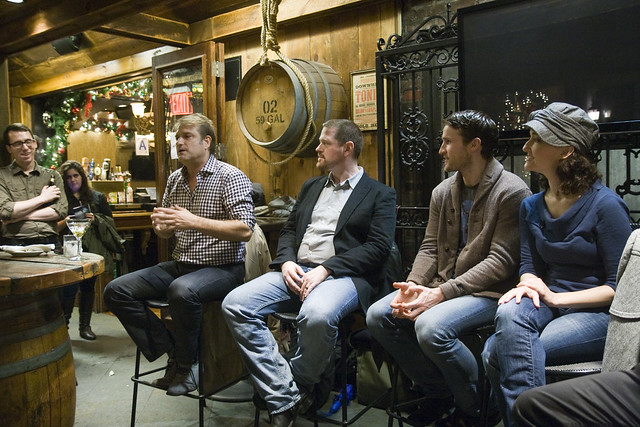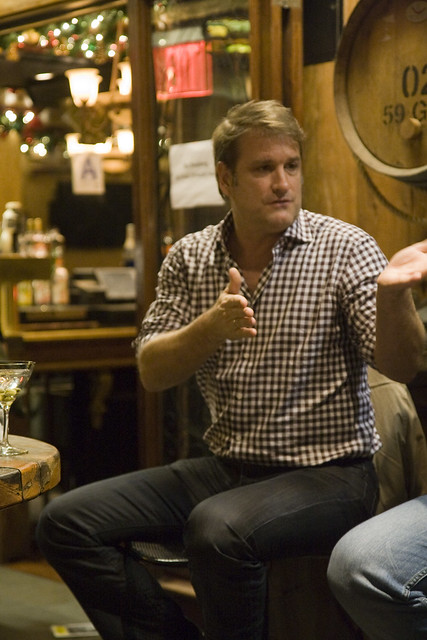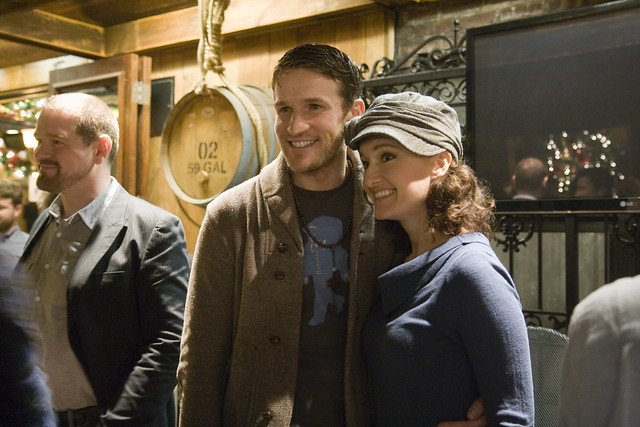To be reprinted on The Clyde Fitch Report when it is relaunched in January 2012.

What is it about gangsters? That seems to be part of the story behind the new musical, Bonnie and Clyde, on Broadway. For three years, they robbed stores, hit up a few banks, ran a gang, murdered at least 14 people (including 9 cops), and ended up dying in a blaze of gunfire as they drove down the road. They both died young, in their early twenties, infamous to the point where, before the corner arrived at the death scene, people cut pieces of bloody clothing off their corpses and even body parts to sell. There is a lot in their story that reflects the American story. So why Bonnie and Clyde on Broadway? Why now?
 On Tuesday Night, after the nightly performance, a short Q&A sponsored by Broadway’s Best Shows was held at Hurley’s saloon where members of the digital press met with Director Jeff Calhoun, Scenic/Costume Designer Tobin Ost, and cast members Claybourne Elder and Melissa van der Schyff. There we engaged with the creative team as they discussed the development of Bonnie and Clyde, the passions they bring to show, and how they engage with some very complex and dynamic historical figures.
On Tuesday Night, after the nightly performance, a short Q&A sponsored by Broadway’s Best Shows was held at Hurley’s saloon where members of the digital press met with Director Jeff Calhoun, Scenic/Costume Designer Tobin Ost, and cast members Claybourne Elder and Melissa van der Schyff. There we engaged with the creative team as they discussed the development of Bonnie and Clyde, the passions they bring to show, and how they engage with some very complex and dynamic historical figures.
For years, Jeff Calhoun had been receiving demos from Wildhorn before Bonnie and Clyde showed up. Three songs from that demo were beautiful, engaging, and spoke to Calhoun. Only one of those songs remains in the show (“God’s Arms Are Always Open”). From there to today took five years of hard work, two cities, and a story that was continually slimmed and refined for Broadway. Jeremy Jordan (Clyde), Laura Osnes (Bonnie), Melissa van der Schyff (Blanche), and Claybourne Elder (Buck) all originated their roles and were thrilled to make it to the big stage. For Jeff Calhoun, Bonnie and Clyde isn’t a musical but rather “a play with music.” In an era of $80 million dollar budgets, Calhoun looked to make something brand new and different on Broadway. “I don’t think you need that kind of money to entertain an audience,” Calhoun said, a jab against the money giants on Broadway. With their own $6 million budget, the goal was to make a show that told the story of Clyde Barrow and Bonnie Parker – a story who tried to explain, but not justify, their story. And in a current world where unemployment is elevated, the Occupy Wall Street movement thrives, and banks are seen as villains, the need to “explain” makes some sense.
But Bonnie and Clyde was never designed to be merely a musical version of the 1967 movie. Many of the questions at the event focused on the movie and the musical’s fit into that canon. The creative team were adamant of creating something brand new, deciding to start off with the characters killed as a way to put the movie behind them. Yet, even with their attempt to kill the movie’s influence on the show, for the digital press team, the influence was very real. Even the discarding of Clyde’s impotence, even though they had to remove one of their favorite elements of the show, didn’t distract the press from making the connections.
And it was also hard to distract the overhanging concern about whether the show will remain open or not. Right before the Tuesday night show, all tickets after January 3rd were refunded (though no official announcement for it was made). Calhoun started the Q&A off with a very tert but expected lament at the press Bonnie and Clyde got from professional critics and even his crack at Ben Brantley’s expense failed to generate any laughter. A question about the different experiences the show has received in each of the three cities it has been too gradually evolved into a discussion about how open and welcoming the city of New York City has been to the show. Both Melissa and Claybourne related that they keep pictures of Buck and Blanche together in their dressing rooms, as a reminder that they are playing real people and trying to honor by being as honest to the characters as possible. And that attention to detail seems to be one of the hooks (besides the amazing vocal talent of Laura Osnes and Jeremy Jones) that the show relies on. And to highlight that attention to detail that the creative team tried to raise up by relating a story of how men in Florida would point out the issues they got wrong with the cars on the set (an attention to detail that I noticed didn’t really work in the character of the preacher of the baptism scene – trying to flip Americana religion pass a seminarian usually won’t work).
 In general, the Q&A tried to raise up the quality of the show (even though they tried their best to distance themselves from the Wildhorn name) by raising up the work they put in the show, the quality of the actors, and the historical research of the Bonnie and Clyde love story. Or at least that was what the press room focused on. The music and lyrics were pushed aside. The story and the book were the focus of the night. And whether that connected with the bloggers in the room, it was hard to say.
In general, the Q&A tried to raise up the quality of the show (even though they tried their best to distance themselves from the Wildhorn name) by raising up the work they put in the show, the quality of the actors, and the historical research of the Bonnie and Clyde love story. Or at least that was what the press room focused on. The music and lyrics were pushed aside. The story and the book were the focus of the night. And whether that connected with the bloggers in the room, it was hard to say.
At the end of the Q&A, Calhoun had a question for all of us, asking if it was possible to create an app where audiences, right after they saw a show, could give a simple thumbs up or thumbs down to a show. For Calhoun, he hoped to record the immediate responses that audiences members had for the play – hoping to gauge and share the emotional connection he honestly believes the audience has with the show (a connection that he believed the professional critics were unable to make). For a show that tried so hard to distance itself from the movies, it struck me as personally odd to try and promote the marketing idea that dominates tv trailers after a poorly received movie comes out: the video of audience members going “I love it!” He really wanted to know if there was an app for that. There isn’t but, based on the questions at the Q&A, the general critical reviews, and my own reaction to the show, I’m not sure hearing “the layperson’s” response is really what they would want to hear.